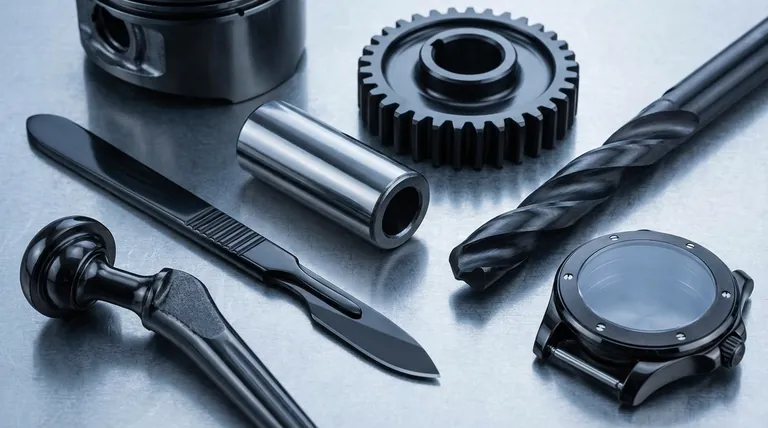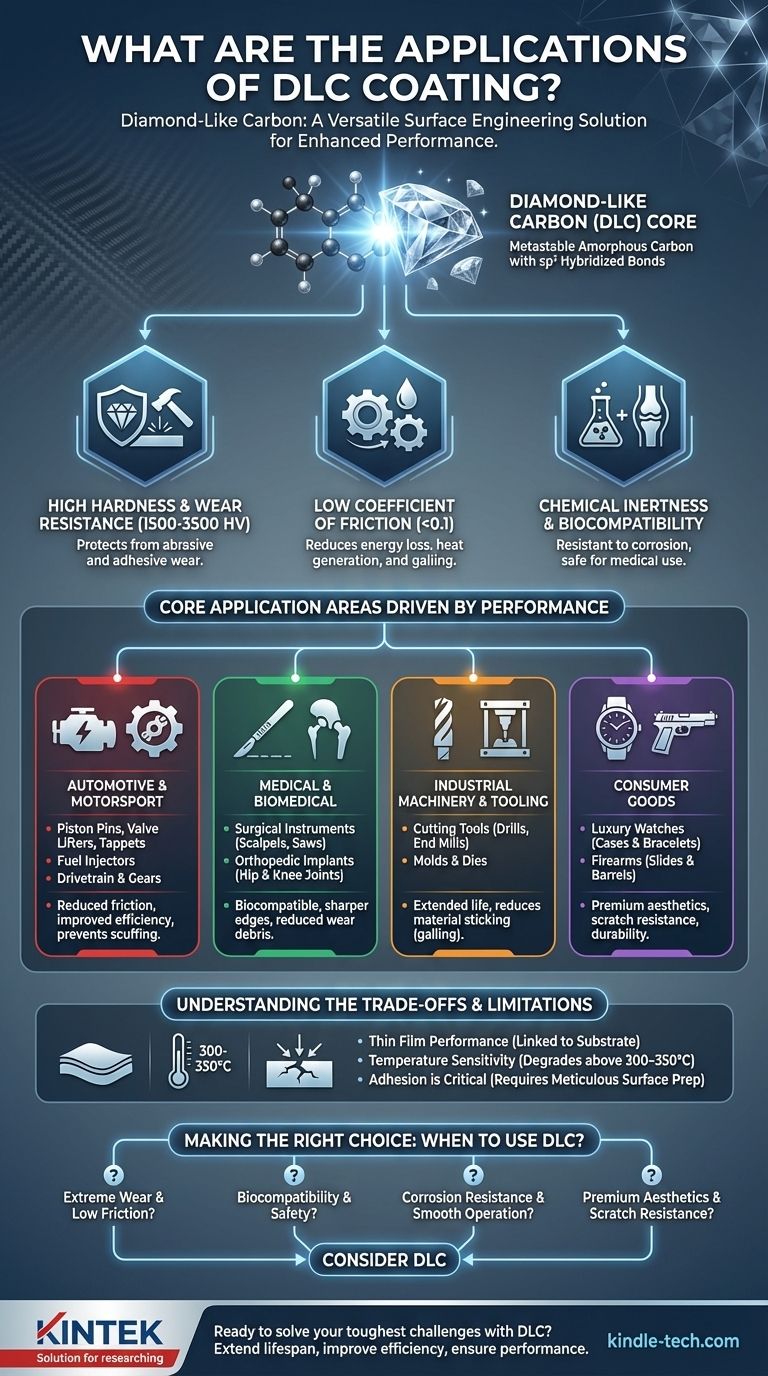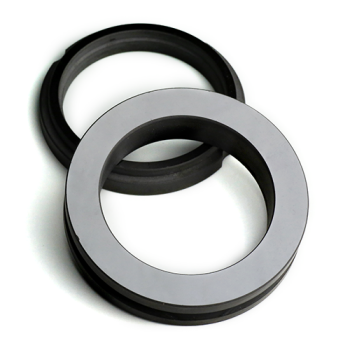At its core, Diamond-Like Carbon (DLC) coating is a versatile surface engineering solution used across a vast range of industries, from automotive and aerospace to medical devices and consumer electronics. Its primary applications involve components that require superior wear resistance, an extremely low coefficient of friction, or a combination of durability and a high-end aesthetic finish. DLC is applied to everything from engine piston pins and surgical scalpels to high-performance cutting tools and luxury watch cases.
The true value of DLC isn't just its hardness, but its unique combination of properties. It solves critical engineering challenges by creating a diamond-like surface on conventional materials, drastically improving performance in environments defined by friction, wear, and corrosion.

The Science Behind DLC's Versatility
To understand DLC's applications, you must first understand the fundamental properties that make it so effective. It is not a single material but a family of amorphous carbon films whose characteristics can be tailored to a specific problem.
Unpacking the "Diamond-Like" Name
The name is not just marketing. While DLC is not crystalline diamond, it is a metastable form of amorphous carbon that contains a significant fraction of sp³ hybridized bonds—the same type of atomic bond found in natural diamond. This structure is the source of its exceptional hardness and durability.
Key Properties Driving Application
Nearly all applications of DLC stem from three core benefits:
- High Hardness & Wear Resistance: DLC coatings are exceptionally hard (typically 1500-3500 HV), protecting components from abrasive and adhesive wear.
- Low Coefficient of Friction: With a friction coefficient rivaling that of Teflon (often <0.1), DLC surfaces are incredibly slick, reducing energy loss, heat generation, and material transfer (galling).
- Chemical Inertness & Biocompatibility: The carbon structure makes DLC highly resistant to acids, bases, and other corrosive agents. It is also biocompatible, meaning it does not provoke an adverse reaction in the human body.
The Coating Process in Brief
DLC is typically applied using a vacuum deposition process, often Plasma-Assisted Chemical Vapor Deposition (PACVD). In this process, a hydrocarbon gas is introduced into a vacuum chamber and ionized into a plasma. These ions are then accelerated toward the component's surface, where they condense and bond to form the dense, hard DLC film. This is a low-temperature process, making it suitable for a wide range of materials, including heat-sensitive steels and alloys.
Core Application Areas Driven by Performance
The combination of hardness, low friction, and inertness makes DLC a problem-solver in many demanding fields.
Automotive & Motorsport: Reducing Friction and Wear
In high-performance engines, reducing parasitic friction losses is key to improving efficiency and power output.
- Engine Components: Piston pins, valve lifters, tappets, and rocker arms are coated to reduce friction and prevent wear under high-load, oil-starvation conditions.
- Fuel Injection Systems: The hardness and chemical inertness of DLC protect critical injector components from wear and corrosion caused by modern fuels.
- Drivetrain & Gears: Coating gears and bearings reduces friction and prevents scuffing, increasing the durability and efficiency of the entire drivetrain.
Medical & Biomedical: Ensuring Biocompatibility and Durability
The medical field relies on DLC for its unique combination of safety and performance.
- Surgical Instruments: Scalpels, saws, and drills are coated to create a harder, sharper edge that stays sharp longer and reduces friction during use. The dark color also reduces glare under operating lights.
- Orthopedic Implants: DLC is applied to the articulating surfaces of hip and knee joints to drastically reduce wear debris and increase the implant's lifespan. Its biocompatibility is non-negotiable here.
Industrial Machinery & Tooling: Extending Component Life
In industrial settings, downtime is the enemy. DLC coatings extend the life of critical components, reducing maintenance cycles.
- Cutting Tools: Drills, end mills, and taps coated with DLC excel at machining non-ferrous materials like aluminum and composites. The low friction prevents material from sticking to the cutting edge (galling).
- Molds & Dies: For plastic injection molding and metal forming, a DLC coating provides excellent abrasion resistance and a low-friction surface for easy part release, improving cycle times and mold life.
Consumer Goods: Aesthetics and Scratch Resistance
Beyond pure industrial performance, DLC provides a premium, durable finish that consumers value.
- Luxury Watches: High-end watch cases and bracelets are coated with DLC to provide a sleek, black finish that is highly resistant to scratches and daily wear.
- Firearms: Components like slides and barrels are coated for enhanced wear resistance, natural lubricity, and a non-reflective tactical finish.
Understanding the Trade-offs and Limitations
While powerful, DLC is not a universal solution. An objective assessment requires understanding its limitations.
It's a Thin Film, Not Bulk Material
The performance of the coating is directly linked to the substrate underneath it. A hard DLC coating on a very soft base material can fail if the substrate deforms under load, causing the coating to crack. Proper material selection and an understanding of load conditions are essential.
Temperature Sensitivity
Most common forms of DLC (hydrogenated variants) begin to degrade at operating temperatures above 300-350°C. In high-heat applications, such as dry high-speed machining of steel, other coatings like TiAlN may be more appropriate.
Adhesion is Critical
The coating is only as good as its bond to the part. Meticulous surface preparation—cleaning, de-stressing, and sometimes applying a bond layer—is absolutely critical for successful application. Coating failure is often adhesion failure.
Not a One-Size-Fits-All Solution
There are many types of DLC (a-C:H, ta-C, Si-DLC, etc.), each with different levels of hardness, internal stress, and friction. Selecting the right type of DLC for the specific application and operating environment is key to success and requires consultation with a coating expert.
Making the Right Choice for Your Application
Use the intended benefit as your guide to determine if DLC is the right solution for your component.
- If your primary focus is extreme wear resistance and low friction: Consider DLC for critical engine parts, high-load gears, or cutting tools for non-ferrous metals.
- If your primary focus is biocompatibility and safety: DLC is a proven, industry-standard choice for medical implants and surgical instruments.
- If your primary focus is corrosion resistance and smooth operation: Use DLC on fuel system components, hydraulic pistons, or molds where sticking is a problem.
- If your primary focus is a premium aesthetic and scratch resistance: DLC provides a durable, high-end finish for consumer luxury goods, firearms, and decorative hardware.
Understanding these core benefits allows you to leverage DLC not just as a coating, but as a strategic design tool to elevate material performance.
Summary Table:
| Application Area | Key Benefits | Common Components |
|---|---|---|
| Automotive & Motorsport | Reduced friction, improved fuel efficiency, wear resistance | Piston pins, fuel injectors, gears, bearings |
| Medical & Biomedical | Biocompatibility, enhanced sharpness, reduced wear debris | Surgical scalpels, orthopedic implants (hips/knees) |
| Industrial Machinery & Tooling | Extended tool life, reduced material sticking (galling) | Cutting tools, injection molds, forming dies |
| Consumer Goods | Premium scratch-resistant finish, durability | Luxury watch cases, firearm components |
Ready to solve your toughest wear, friction, or biocompatibility challenges with DLC coating?
At KINTEK, we specialize in advanced surface engineering solutions for laboratories and industry. Our expertise in applying Diamond-Like Carbon coatings can help you:
- Extend the lifespan of critical components.
- Improve efficiency by reducing friction and energy loss.
- Ensure safety and performance for medical and consumer applications.
Let our experts help you select the right DLC formulation for your specific material and operating environment. Contact KINTEK today for a consultation and discover how our lab equipment and consumables can elevate your project's performance.
Visual Guide

Related Products
- Custom CVD Diamond Coating for Lab Applications
- CVD Diamond Cutting Tool Blanks for Precision Machining
- Glassy Carbon Sheet RVC for Electrochemical Experiments
- High-Purity Titanium Foil and Sheet for Industrial Applications
- Hydrophilic Carbon Paper TGPH060 for Battery Lab Applications
People Also Ask
- What is the process of CVD diamond coating? Grow a Superior, Chemically-Bonded Diamond Layer
- Is diamond coating worth it? Maximize Component Life and Performance
- Is diamond coating permanent? The Truth About Its Long-Lasting Durability
- What is diamond coating film? A Thin Layer of Diamond for Extreme Performance
- What are diamond coated films? Enhance Materials with Super-Hard, Transparent Layers










